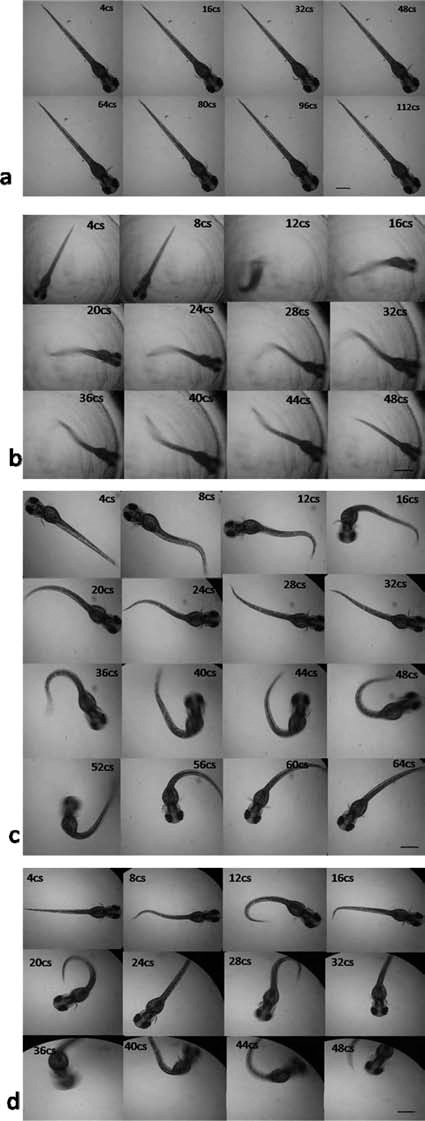
Annals of Neurosciences, Volume 19, Issue 1 (January), 2012
Rapid neurobehavioural analysis based on the effects of an acetylcholinesterase inhibitor from Tephrosia purpurea in Zebrafish
KEY WORDS
Alzheimer’s disease
Tephrosia purpurea
Acetylcholinesterase
Corresponding Author:
S. G. Prakash Vincent, Ph.D
Tel : +91 4652 250200
E-mail : vsgprakash.icn@gmail.com
ABSTRACT
Background: Zebrafish is an important model organism for human neurobehavioural studies and compound screening for neurodegenerative disorders like Alzheimer’s disease and dementia. Purpose: We wanted to analyse the rapid neurobehavioural effects based on acetylcholinesterase inhibitors from Tephrosia purpurea in zebrafish. Methods: Tephrosia purpurea (a herbal neuroactive molecule) extract was analyzed for its rapid neurobehavioural effects and the corresponding psychotic twitches were quantified. The inhibitory activity of acetylcholinesterase was analysed in Zebrafish. The activity of the molecule was confirmed after column chromatography and RP-HPLC purifications. The toxicity of the molecule was also studied in developing zebrafish embryos. Results: The psychotic body twitches were calculated as crude 484.67 ± 18.01 at 10 μg/mL, column purified 616 ± 9.64 at 8 μg/mL, Sep-Pak C18 712.67 ± 19.5 at 6 μg/mL, and HPLC elution showed 815 ± 14.93. The minimum inhibitory concentration of acetylcholinesterase in crude and column purified was 100 ng/mL and 5 ng/mL. The IC50 value of acetylcholinesterase inhibitor was calculated as 626ng/mL for crude (P<0.0001), 28.92 ng/mL for Sep-Pak column elution and 64 ng/mL for Donepezil. The HPLC fifth elution showed inhibition percentage as 96.97 ± 0.12. The organogenesis effects were seen in the drug concentration of 10 μg/mL. Pericardial bulging, trunk and tail flexure with heart edema and head edema were observed in the embryos at higher dose of 30- 40 μg. The LC50 value was 34.87 μg/mL. The studies showed that the inhibitory concentration of acetylcholinesterase is comparatively higher than Donepezil. Conclusions: Rapid behaviour based screening is an inexpesive assay to identify neuroactive small molecules. This herbal can be further used for the development of drugs for Alzheimer’s disease.
doi : 10.5214/ans.0972.7531.180403
Introduction
Alzheimer’s disease (AD) is characterized by neuronal degradation that results in loss of cognitive functions, such as memory, communication skills, judgment and reasoning.1 AD patients suffer from the reduction of cholinergic neuronal function in brain responsible for mental functions. Cholinergic activity loss is due to the substantial reduction of choline acetyltransferase (ChAT) activity which is responsible for the synthesis of acetylcholine (ACh). Acetylcholinesterase (AChE) is a serine hydrolase which rapidly hydrolyzes the neurotransmitter acetylcholine into choline and acetic acid.2 This process happens in the cholinergic synapses of neuromuscular junctions of the nervous system. Zebra fish AChE is the only ACh-hydrolyzing enzyme in this organism and it is highly homologous to mammalian AChE.3 Also, the zebrafish genome does not express a functional butyrylcholine esterase, a related enzyme that can also hydrolyze Ach.3 Hence in our study, we have used the Zebrafish as a model organism for humans to analyse the AChE inhibitory activity studies from herbals. AChE inhibitors can be used for the treatment of the autoimmune disease Myasthenia gravis, glaucoma, and Alzheimer’s disease.4
Cholinesterase inhibitors can be used for the treatment of dementia such as vascular dementia, Parkinson’s disease and multiple sclerosis dementia.5 Donepezil is the most frequently prescribed ChEI 6,7 and approved by the U.S. Food and Drug Administration (FDA) as possible marketable compound inhibitor with potential therapeutic benefit in Alzheimer’s disease. Expression of AChE can also be detected in many primary neurons of the Zebrafish embryo, including both motor neurons and sensory neurons, which differentiate in the nascent central nervous system during early somitogenesis stages.8 SV2 is a transmembrane keratan sulfate proteoglycan of synaptic vesicles, found in neuronal and endocrine cells.9 It exists in two forms, heavy and light that differs in glycosylation.10 The resynaptic axon terminal is hallmarked by a large number of synaptic vesicles orderly clustered around the active zone where synaptic vesicles undergo exocytosis to release neurotransmitters.11 Zebrafish AChE is highly related to that of mammals.3 Since zebrafish has been used as a model to study the AChEI we have analyzed the neurotoxicity during brain development and genetic effects. The present study has been designed to analyse the rapid neurobehavioural effects based on acetylcholinesterase inhibitory activity from Tephrosia purpurea in the brain of Zebrafish model.
Methods
Sample preparation and extraction
Tephrosia purpurea samples were collected from Shenbagaramanputhoor, Western Ghats of Kanyakumari, Tamilnadu, India and the leaves were washed with tap water, distilled water, shade dried and grounded to get 10 g of leaf powder. It was extracted with 250 mL of organic solvents (hexane, chloroform, acetone and methanol) for 12 h each and extracted based on their increasing polarity, using Soxlet apparatus. The organic solvents were evaporated and concentrated in a Concentrator (Eppendorf 5301) and stored at 4°C for further analysis.12
Animals
Zebrafishes were bred and maintained in Fish Culture facility of International Centre for Nanobiotechnology, M.S. University (Ethical Approval number for animal usage: ICN/CMST/MSU/2009-ZF4). Zebrafishes were maintained in 30 L tanks at 28°C with 14 h: 10 h light/dark cycle. Following successful breeding eggs fell through the mesh, and were subsequently collected from the bottom of tanks. Zebrafish embryos were raised in E3 medium (5 mM NaCl, 0.17 mM KCl, 0.4 mM CaCl2 and 0.16 mM MgSO4 in 1 L DD.H2O.). Eggs containing dead or obviously poor quality embryos were removed. The remaining embryos were used, usually within 2 h post fertilization (hpf), for developmental toxicity assays. Embryos were raised in HEPES (10 mM) buffered E3 medium in a dark incubator at 28°C until 60 h after fertilization. One/two embryos were distributed into the wells of flat-bottomed, 96-well plates filled with E3 medium (360 μL). Embryos were then incubated in a dark incubator at 28°C for subsequent experiments.
Rapid behavioural repertoire assay and image acquisition
1 mg/mL of Tephrosia purpurea extract was prepared in Embryo Rearing Solution (ERS) as stock solution. To assess the neurobe-havioural effects on the larval zebrafish, the phytomolecules were serially diluted for 1-100 μg/mL of working solution from stock solutions. The herbal extract was added in 96 well plates for all the four source of extracts with triplicate in each. Compounds were added to the wells in 1%DMSO as small molecule vehicle and the DMSO alone was used as a control. The rapid neuroactive behaviour was studied by treating the extract in 4 dpf embryos and the psychotic twitches studied in Image Editing Software tool Adobe Premiere 6.5. 1500 frames were generated from 1 min video and one frame was generated in every 4cs. The psychotic twitches were analyzed and quantified from the 1500 frames generated. Video microscopy was performed on (Motic) Light microscope with the 4x objective lens and Canon Ixus digital camera (10 Mega pixel) with a shutter speed of 0.04s was used for image acquisition. The kinematic behaviour was studied in column (Silica Gel and Sep-Pak C18) and HPLC elutions.
Acetylcholinesterase inhibition assay
300 – 500 mg (body weight) Zebrafishes were used for the experiment. The fish were decapitated 4 mg of brain was carefully dissected and placed in ice-cold buffer (phosphate buffer pH 7) in a petridish chilled on crushed ice. The brain tissues were homogenized in 1mL of 100 mM phosphate buffer (pH -7). The homogenate was centrifuged for 3000 rpm for 10 minutes at 4˚C. 40 μL aliquot of the supernatant was added to a 96 well microtitre plate containing 260 μl of phosphate buffer (pH- 7) The tissue homogenate was incubated with Tephrosia purpurea was dissolved in 1%DMSO in phosphate buffer (pH 7). 0.01-100 μg/mL of extract was assayed in a 96 well microtitre plate containing 260 μl of phosphate buffer (pH 7) for 45 min at RT. Enzyme control contained Tris–HCl buffer pH 8.0 instead of the plant extract. The reaction was stopped by the addition of 0.5M Tris–HCl pH 8.0. Cholinesterase activity was assessed by the addition of 10 μl of DTNB (5,5-dithiobis [2-nitrobenzoic acid]) as chromogen and 2 μL of acetylthiocholine iodide (ATCI) as substrate. The rate of hydrolysis of ATCI was observed as change in absorbance at 412 nm every minute for 10 min in the Microplate reader (Molecular Device). The inhibitory concentration was calculated from 10 mg/ml of working solution by serially diluting the column purified small molecule of 25-500 ng/mL. Donepezil, a reversible inhibitor of cholinesterase, which was used as an effective drug for the treatment of AD, was used as a standard drug, 0.005–100 μg/mL.14 The assay was repeated in Silica gel column and Sep-Pak column to quantify the inhibitory concentration of purified extract. Percentage inhibition of the plant extract was calculated as the following formula.13
(Enzyme activity of control - Enzyme activity with Enzyme inhibitor / Enzyme activity of control) x 100.
Purification of Acetylcholinesterase inhibitor
Column Chromatography (Silica gel and Sep-Pak C18 Column)
A sterile glass column (2.5 x 50cm width and length) was taken and rinsed with hexane and a mixture of silica gel (60-120 mesh) slurry was poured carefully onto the top of the column and eluted. 10 mg of the sample from hexane extract of Tephrosia purpurea was dissolved in 1mL of the HPLC grade acetonitrile. 1g of silica gel (60-120 mesh) was added into the solvent with extract. Then the slurry with the compound was evaporated in vacuum concentrator (Eppendorf 5301). The compound mixture was then carefully added into the column with a glass funnel. The silica gel powder was added over the loaded sample to avoid disturbance while pouring the organic solvents. The fractions were eluted from the column using benzene:acetonitrile in the ratio from 5:100% to 100:5% and then methanol (HPLC grade) was used to elute the remaining compounds and totally 20 fractions were made. All the fractions were concentrated in Concentrator (Eppendorf 5301) at 30˚C for further experiments. The fractions with similar rapid neuroactivity and AChEI activity were pooled and 10 gradient elutions with C18 Sep-Pak Column (Waters) were made. The Sep-Pak C18 elution was made with 1 gradient elution of HPLC grade acetonitrile and HPLC water in a ratio of 9:1 to 1:9. The active fraction eluted in Sep-Pak C18 Column was evaporated and concentrated in Vacuum Concentrator (Eppendorf). The absorption maxima of the active fractions were determined spectrophotometrically (Techcomp, UV VIS 8500) by taking 1 mg of the compound dissolved in 1 ml of acetonitrile (HPLC grade) and vortexed for 5 minutes (Genei). 250 μl of the supernatant was made up to 2 ml with the HPLC mobile phase (acetonitrile:water, 65:35) and the absorbance values were scanned between 200 nm to 800 nm range. The HPLC mobile phase was used as blank.
RP-HPLC Purification
The high performance liquid chromatographic (HPLC) analysis was carried out on a HPLC system (Cyberlab) using C18 column. The solvent system acetonitrile and water (HPLC grade) was used in the ratio of 65:35. The mixture was premixed and sonicated in the sonicator for 15 min. The flow rate was 1ml/min and the temperature was set at 30˚C. The UV-Vis detector was set at 256 nm Tephrosia purpurea. The samples were filtered using 0.22 μm filter before injection. About 25 μL of the sample filtrate was injected into the column. The sample was run for 8 min and 8 elutions were collected from the HPLC run and the eight runs have been checked for its neurobehavioural activity and Acetylcholinesterase activity. The elution was repeated for 10 times to get 10 mL of each elution from 8 minutes run. The solvents were evaporated in vacuum concentrator (Eppendorf, 5301) in the 2 mL microfuge tubes (Eppendorf) for further studies.
Pharmacological assessment and toxicity
Organogenesis effects were visually evaluated for developmental retardation, morphological abnormalities (brain, eye, ear, somite, notochord, trunk, tail, fin), cardiovascular defects (heart morphology, heart rate, circulation), and overall appearance in the Light microscope (Motic).15 The Blood Cell Counting and Heart Beat Rates were carried out according to Kannan et al.15 The LC50 Values were calculated as per the OECD regulations.16
Statistical analysis
Each experiment was performed at least three times, and all values presented are the means ±SD of triplicate assays. T-test was used to analyze the statistical significance of the results. P values <0.05 were considered statistically significant.
Results
Hexane extract of Tephrosia purpurea (TP) showed rapid neurobehaviour activity and the image acquisition analysis showed unique behavioural repertoire (Fig. 1). These locomotor patterns have proven to be a powerful approach for neurobiological analysis.17 The crude extract of TP showed the fast burst twitches which bends in all angles with very high vibration twitches as observed in the videos and shown in Fig. 1b. 25 frames of images were obtained for 1 sec video. Severe vibrational twitches were observed in the head region of HPLC elution also during the locomotor behaviour and can be visualized in the Images shown (Fig. 1d). The psychotic twitches of the neuroactive compound showed very fast latency bends in all the angles and followed by heavy burst swims. The psychotic twitches were observed in all the directions of the Zebrafish embryos. Many distinctive kinematic features were observed in the column purified neuroactive small molecule (Fig. 1c) and HPLC purified neuroactive small molecule (Fig. 1d). The neuroactivity was found in the Silica gel elutions 15, 16 and 17. Elutions with similar neuroactivity was pooled to get elution in Sep-Pak C18. In Sep-Pak C18, the elution 5, 6 and 7 showed maximum locomotor behaviours which was quantified after pooling the three elution. Interestingly we found the AChE inhibitor activity of both type of column elutions showing rapid locomotor behaviour. The Sep-Pak C18 elution was scanned for its maximum absorption which showed 256 nm in the UV-VIS nanodrop. The psychotic body twitches were calculated as crude 484.67 ±18.0093 at 10 μg/mL, column purified 616 ±9.64 at 8 μg/mL, Sep-Pak C18 712.67 ±19.5 at 6 μg/mL, HPLC elution 815 ±14.93 and controls showed activity of 5.33 ±2.52, 3 ±1, 3.33 ±0.58 and 4.33 ±0.58 respectively with highly significant (P<0.0001). The psychotic twitches of the locomotor activity were measured in th crude, column (Silica gel and Sep-Pak C18) and HPLC elution. The rapid neuroactive behavioural twitches and the kinematic manoeuvre of the 4 dpf larval zebrafish were depicted in Fig. 2 and resulted in 90.88, 205.33, 213.8 and 188.08 fold higher than each controls respectively.
Acetylcholinesterase inhibition was found in the hexane extract of the Tephrosia purpurea and the column purified small molecule is shown in Fig. 3A and 3B. The inhibitory concentration was calculated by serially diluting the crude extract from 0.01-50 μg/mL and 5-500 ng/mL (for Sep-Pak C18 column purified small molecule) and the inhibition percentage was calculated (Fig. 3D and 3E). The acetylcholinesterase activity was represented in a concentration dependent manner. The acetylcholinesterase inhibitory (AChEI) activity was evident for the commercial drug Donepezil to compare with the activity of TP (Fig. 3C). The inhibition percentage of Donepezil was calculated (Fig. 3F). The minimum effective concentration of acetylcholinesterase inhibition was 100 ng/mL for crude, 5 ng/mL for Sep-Pak elution and 5 ng/mL for Donepezil. The IC50 value of acetylcholinesterase inhibitor was calculated as 626 ng/mL for crude, 28.92 ng/mL for Sep-Pak column elution and 64 ng/mL for Donepezil (P < 0.0001). RP-HPLC elution was measured at 256 nm and the neuroactive molecule for rapid behaviour activity and acetylcholinesterase. The inhibition percentage in fifth elution of HPLC showed 96.97 ± 0.12 and the R value (Rate of reaction) was found to 0.0031 ± 0.0001 moles/min/g tissue which is comparatively better than the column and crude extract. The neuroactivity and AChEI was present in molecules with a retention time of 4.21 and 4.64 min (Fig. 4).

Fig. 1: a) Untreated embryos without body twitch at 4 dpf. b) Kinematic behavioural repertoire of Hexane extract of Tephrosia purpurea. 12cs - 44cs shows severe vibrational bursting twitches in the trunk and caudal region. The vibrational body twitches activity showed blurred tail twitches during video recording. c) Behavioural Kinematic analysis of Sep-Pak column elution of Tephrosia purpurea. Different maneuvers of distinctive kinematic feature are seen. J turn, fast latency bends with bursting, Latency C bends, routine returns (R-turns), Large C bends are observed in the images (8cs - 64cs). d) Rapid Neurobehaviour activity of fifth HPLC elution showed severe heavy vibrational bursting twitches in the head with C and J bend.

Fig. 2: Rapid behavioural psychotic body twitches of the neuroactive molecule from TP (P<0.0001).
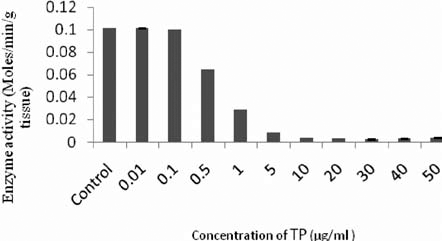
Fig. 3A: Acetylcholinesterase inhibitory activity of hexane extract of Tephrosia purpurea.
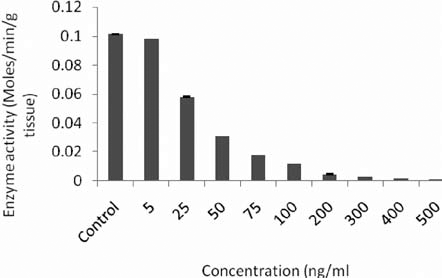
Fig. 3B: Acetylcholinesterase inhibitory activity of Sep-Pak C18 colum elution of Tephrosia purpurea.
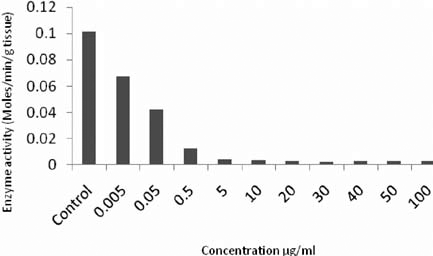
Fig. 3C: Acetylcholinesterase inhibitory activity of Donepezil (Positive control) in Zebrafish brain.
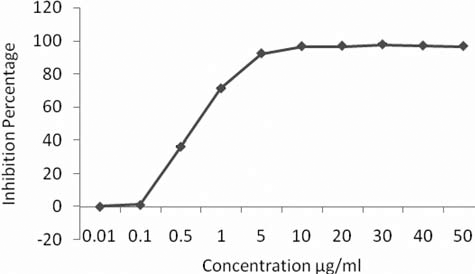
Fig. 3D: Acetylcholinesterase inhibition percentage by hexane extract of T. purpurea.
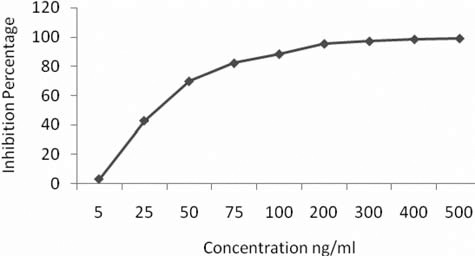
Fig. 3E: Acetylcholinesterase inhibition percentage by Sep-Pak C18 purified molecule of T. purpurea.
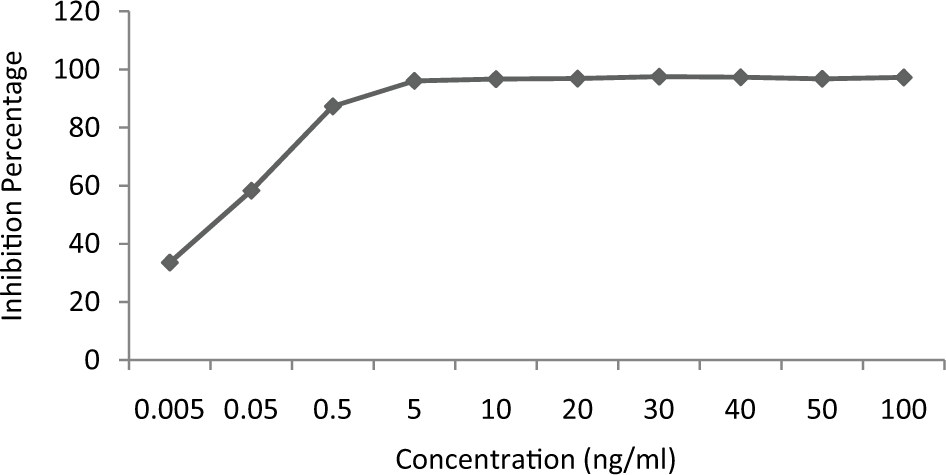
Fig. 3F: Acetylcholinesterase inhibition percentage by Donepezil (Positive control) in zebrafish.
There was no notable increase in the HBR and the level of BCC. However the organogenesis effects showed pericardial bulging, trunk and tail flexure with heart edema, head edema and brain developmental defects (Fig. 5). The LC50 was determined by probit analysis and the lethel concentration was calculated as 34.87 μg/mL (with 95% confident limit). The lower limit is 28.047 μg/mL and the upper limit is 40.914 μg/mL for the crude hexane extract of TP.
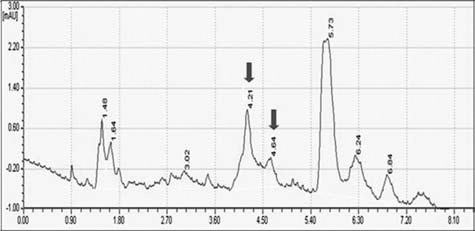
Fig. 4: RP-HPLC purification of neuroactive compound from Tephrosia purpurea.
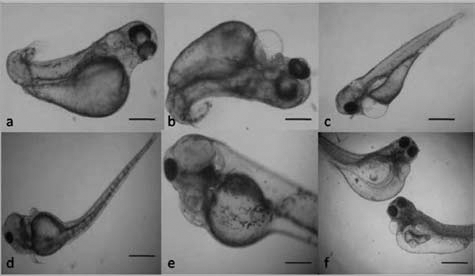
Fig. 5: Physiological assessment of TP in zebrafish embryos (30-40 μg/mL). a) Head edema with stunted growth in the caudal region/tail flexure. b) Pericardial bulging, edema in the yolk and cardiac region. c) Gut deformity. d) Abnormal tail, trunk and spinal cord development. e) Magnified image of (Fig. 5d) showing head edema and small eye (Chemical genetic effect). f) Severe damage in the intestine, heart, bradycardiac formation and no blood flow observed in the LC50 concentration of TP treated in the zebrafish embryos.
Discussion
Hexane extract of Tephrosia purpurea showed rapid locomotor activity in the crude extract at 10 μg/mL and the Sep-Pak C18 column purified showed the neuronal behaviour at 1 μg/mL and the heavy bursting neuronal activity was found in HPLC elution also but the molecule was not quantified. The locomotor activity was found higher in Zebrafish larvae, this locomotor activity supports the early emergence of olfactory system. The olfactory epithelium is developed and the beating cilia facilitate water flow within the nares and active neural connectivity to the olfactory bulb.18 Hence the small molecule will be directly interacting with the olfactory system for the locomotor behaviour. The acetylcholinesterase inhibition and locomotor activity was found in the HPLC purified and Column purified neuroactive molecule in the zebrafish. This proved that the acetylcholinesterase inhibitor stimulated the locomotor behaviour in zebrafish embryos. Dementia adversely affects memory, thinking, comprehension, judgement, orientation, calculation and language. Patients with AD suffer from the reduction of cholinergic neuronal function in those areas of the brain responsible for higher mental functions, which partially accounts for the impairments in activities of daily life.19 The locomotor behaviour of this neuroactive molecule would be potential therapeutic molecule for neurological disorders. In this study, it has proved that the potential Rapid locomotor behaviour and potential AChE inhibitory activity was found in RP-HPLC eluted molecule also. Hence, it can be concluded that this molecule has the potential of both type of neuroactivity. Loss of cholinergic activity is due to substantial reduction in the activity of the enzyme choline acetyltransferase (ChAT) responsible for the synthesis of acetylcholine. One promising strategy for the treatment of AD has been to use ChE inhibitors to increase the levels of ACh in the synapse, thereby enhancing cholinergic activity in the affected regions of the brain. Currently tacrine, rivastigmine, donepezil and galanthamine have been approved by Food and Drug Administration in United States for the treatment of AD pathology.19 Hepatotoxicity and gastrointestinal disorders are a great interest in finding better cholinesterase inhibitors from natural sources.20 The AChE activity was measured by Ellman’s colorimetric method.13 In the present work AChE inhibitory activity was found in the hexane extract of Tephrosia purpuria and similar activity was found in the halophilic plants H. valentiae, U. retiuclata showed dual cholinergic activity i.e., they are active against both AChE and BuChE.21 It is evidently found that Butyrylcholine esterase. Plant extracts, which have dual anti-ChE activity, may be appropriate to patients in moderate stage of AD.22 Inhibition of AChE stimulates the cholinergic neruotransimission and reduces the aggregation of amyloidal in the brain,23 Donepezil the currently used ChE inhibitor has been reported to activate secretase and promote nonamyloidogenic pathway.24 A recent report also demonstrated that selective BuChE inhibitors reduced amyloid precursor protein processing and level in vivo and in vitro.25 Therefore, cholinesterase inhibitors not only increase the level of ACh but also prevent the formation of beta amyloidal plaques thereby protecting the neurons from neurodegeneration. Enzyme kinetic analysis showed that H. valentiae, U. reticulate exhibited mixed type inhibition of AChE and BuChE.21 This type of noncompetitive ‘mixed’ type inhibition was also found in tacrine and physostigmine,26,27 licensed drugs used in the treatment of AD.
Conclusions
The main finding of the present study proved that neuroactive molecules from nature can be screened by simple behavioural assays in zebrafish embryos. In this study we can conclude that the hexane extract of Tephrosia purpurea has potent AChE Inhibitory activity and thus it could be further characterized as a novel drug molecule for the treatment of Alzheimer’s disease.
The article complies with International Committee of Medical Journal Editor’s uniform requirements for the manuscripts.
Competing interests: None, Source of Funding: None
Received Date : 15 September 2011; Revised Date: 15 December 2011
Accepted Date : 13 January 2012
References
1. Lanctot KL, Herrmann N, Yau KK, et al. Efficacy and safety of cholinesterase inhibitors in Alzheimer’s disease: a meta-analysis. Canadian Medical Association Journal 2003; 169: 557–64.
2. Massoulié J, Pezzementi L, Bon S, et al. Molecular and cellular biology of cholinesterases. Prog Neurobiol. 1993; 41: 31–91.
3. Bertrand C, Chatonnet A, Takke C, et al. Zebra fish acetylcholinesterase is encoded by a single gene localized on linkage group 7 gene structure and polymorphism: Molecular forms and expression pattern during development. J Biol Chem. 2001; 276(1): 464–474.
4. Soreq H and Seidman S. Acetylcholinesterase—new roles for an old actor. Nat Rev Neurosci. 2001; 2: 294–302.
5. Kloszewska I. Acetylcholinesterase inhibitors—beyond Alzheimer’s disease. Psychiatri Pols. 2002; 36(6 Suppl): 133–41.
6. Auriacombe S, Pere JJ, Loria-Kanza Y et al. Efficacy and safety of rivastigmine in patients with Alzheimer’s disease who failed to benefit from treatment with Donepezil. Curr Med Res Opin. 2002; 18: 129–138.
7. Bullock R and Connolly C. Switching cholinesterase inhibitor therapy in Alzheimer’s disease–donepezil to rivastigmine, is it worth it? Int J Geriat Psychiat. 2002; 17(3): 288–289.
8. Hanneman E, Trevarrow B, Metcalfe WK, et al. Segmental pattern of development of the hindbrain and spinal cord of the zebrafish embryo. Development 1988; 103: 49–58.
9. Buckley K and Kelly RB. Identification of transmembrane glyco- protein specific for secretory vesicles fo neural and endocrine cells. J Cell Biol. 1985; 100: 1284–1294.
10. Scranton TW, Iwata M and Carlson SS. The SV2 protein of synaptic vesicles is a keratan sulfate proteoglycan. J Neurochem 1993; 61: 29–44.
11. Dresbach T, Qualmann B, Kessels MM, et al. The presynaptic cytomatrix of brain synapses. Cell Mol Lif Sci. 2001; 58: 94–116.
12. Rajaretinam RK and Vincent SGV. Isolation of a novel bioactive compound from Rhizophora mucronata for methicillin resistant Staphylococcus aureus (MRSA) and Compound toxicity assessment in Zebrafish embryos. J Pharm Res. 2010; 3(8): 2000–2003.
13. Ellman GL, Courtney KD, Andres V, et al. A new and rapid colorimetric determination of acetylcholinesterase activity. Biochem Pharmacol. 1961; 7: 88–95.
14. Kosasa T, Kuriya Y, Matsui K, et al. Inhibitory effect of orally administered donepezil hydrochloride, a novel treatment for AD, on cholinesterase activity in rats. Europ J Pharmocol. 2000; 389: 173–179.
15. Kannan RR, Jerley AJA, Ranjani M, et al. Antimicrobial silver nanoparticle induces organ deformities in the developing Zebrafish (Danio rerio) embryos. J Biomed Sci Engg. 2011b; 4: 246–252.
16. OECD. Test Guideline 203 OECD Guideline for Testing of Chemicals Fish, Acute Toxicity Test 1992.
17. Fero K, Yokogawa T and Burgees HA. The behavioural repertoire of larval Zebrafish, Kalueff AV, Cachat JM, (eds), Zebrafish models in Neurobehavioural Research. Neurometh. 2011; 52: 249–290.
18. Li J, Mack JA, Souren M, et al. Early development of functional spatial maps in the zebrafish olfactory bulb. J Neurosci. 2005; 25: 5784–5795.
19. Zarotsky V, Sramek JJ and Cutler NR. Galanthamine hydro-bromide: an agent for AD. Am J Healt Sys Pharm. 2003; 60: 446–452.
20. Park CH, Kim SH, Choi W, et al. Novel anticholinesterase and antiamnesic activities of dehydroevodiamine, a constituent of Evodiarutaecarpa. Plant Medic 1996; 62: 405–409.
21. Suganthy N, Pandian SK and Devi KP. Neuroprotective effect of seaweeds inhabiting South Indian coastal area (Hare Island, Gulf of Mannar Marine Biosphere Reserve): Cholinesterase inhibitory effect of Hypnea valentiae and Ulva reticulate. Neurosci Lett. 2010; 468: 216–219.
22. Giacobini E. Cholinesterases: new roles in brain function and in Alzheimer disease, Neurochem Res. 2004; 28: 515–522.
23. Hodges JR. Alzheimer’s centennial legacy: origins, landmarks and the current status of knowledge concerning cognitive aspects. Brain 2006; 129: 2811–2822.
24. Zimmermann M, Gardoni F, Marcello E, et al. Acetylcholinesterase inhibitors increase ADAM 10 activity by promoting its trafficking in neuroblastoma cell lines. J Neurochem. 2004; 90: 1489–1499.
25. Greig NH, Utsuki T, Yu Q, et al. A new therapeutic target in Alzheimer’s treatment: attention to butyrylcholinesterase. Curr Med Res Opin. 2001; 17: 159–165.
26. Alhomida AS, Al-rajhi AA, Kamal MA, et al. Kinetic analysis of the toxicological effect of tacrine (Cognex) on human retinal acetylcholinesterase activity. Toxicol. 2000; 147: 33–39.
27. Perola E, Celai L, Lamba D, et al. Long chain analogs of physostigmine as potential drugs for AD: new insight into the mechanism of action in the inhibition of acetylcholinesterase. Biochim Biophys Acta. 1997; 1343: 41–50.